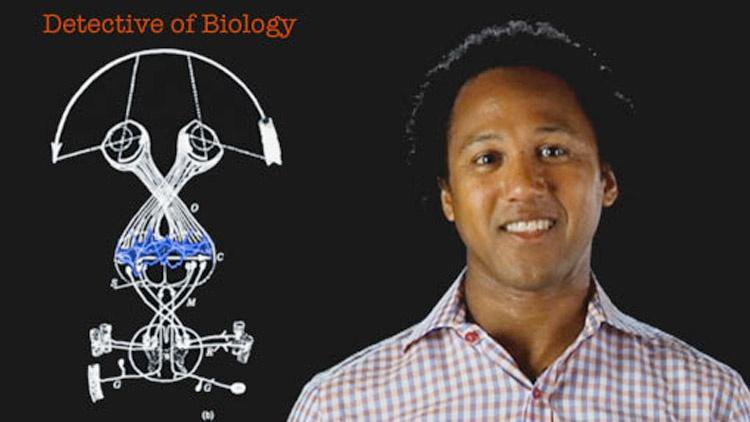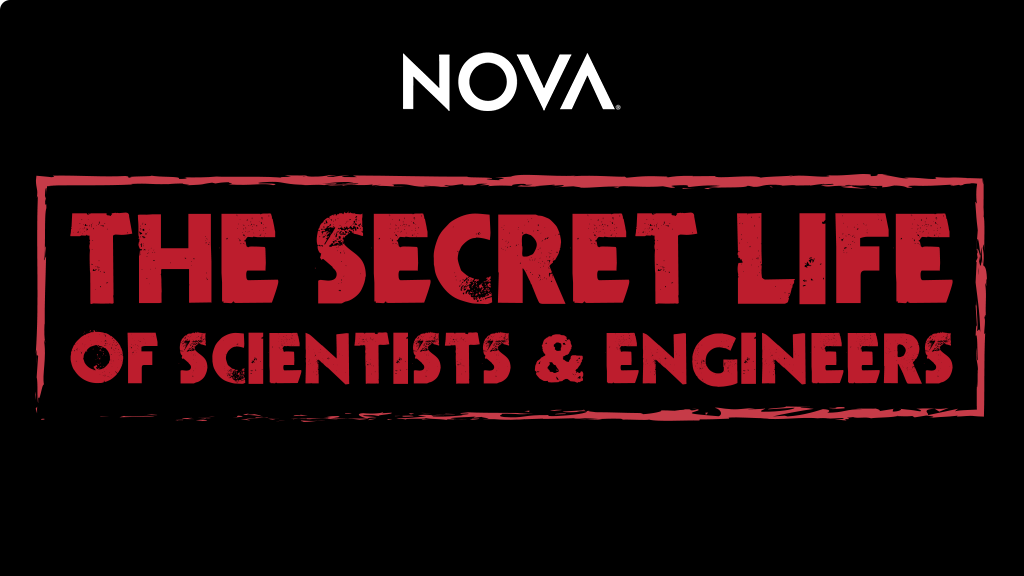Andre Fenton
Andre Fenton is Professor of Neural Science at the Center for Neural Science at New York University. He is also a part-time Associate Professor of Physiology and Pharmacology at SUNY Downstate Medical Center. He is especially interested in understanding how memory works (and doesn’t work).

Meet neurobiologist André Fenton in these videos, blog posts, and interviews from NOVA's "The Secret Life of Scientists & Engineers." André explains how our perceptions influence our thoughts. He studies perception, how the brain stores experiences, and how people use those stored experiences to organize their thoughts. He frequently meditates while sitting and running to strengthen his focus.
“My brain has a particular take on the world.”
Science:
Andre Fenton is a neurobiologist who believes that the brain may not be eternal, but it is spotless.
Secret:
Andre’s meditating has taught him to focus like a laser beam in all areas of his life.
Detective of Biology
Andre Fenton tells us about "The Hardy Boys," frogs, and being a sleuth of the mind.
30 Second Science with Andre Fenton
We give Andre Fenton 30 seconds to describe his science and he tells us that he studies how we organize our thoughts.
10 Questions for Andre Fenton
We ask Andre Fenton 10 questions and he sees "patterns of light."
“What You Think, You Become.” Wow! Really?
By: Andre Fenton
I’ve been fascinated about thoughts, how they arise, and how immensely valuable they can be. Once I had embraced a few foundation principles of neuroscience, it seemed self evident that experience must be fundamentally subjective and determined by the wiring and function of an individual’s brain. One of those principles is summarized by the equality: “experience = brain activity.” In a sense this means my reality is the activity of my brain, nothing more, nothing less. That equality has challenged and soothed me, and for a rather long while, believing it made me feel like I understood something fundamental that was important in an everyday sort of way. The consequence was that I would focus my efforts on working out how neurons and brains operate.
A while back, an unsettling realization that my understanding of the equality was superficial began to percolate. Perhaps my thinking had been lazy and I had stopped short of what is a truly powerful, fundamental understanding. A very long time ago, Siddhartha Gautama, better know as Buddha, may have got it right when he said “What you think, you become.” The more I learn about neurons, brains, myself and other people, the truer that insight seems.
“What you think, you become.” That’s powerful; an understanding that can transform a lot, if not everything. If it is true, then thoughts, the network operations of brain cells, both define and can change a person, and possibly the world. I see dramatic examples all around me. Today’s inspiring examples appear to be the regime-changing news from Tunisia and Egypt. It seems there is nothing better to do for myself, and possibly everyone else, than to think clearly and well. I work to understand the nuts and bolts of how thinking works. I wonder if what Siddhartha said is true? Regardless, I’m enjoying trying to pass the thought along – “What you think, you become.” I hope we will all understand what that really means.
The Secret (Inner) Life of Andre
Working hard at just about any pursuit—laboring and thinking deeply—can lead to new self-knowledge. But some people choose a particular pursuit because they believe that the very “stuff” of that pursuit—what they’re doing, what they’re learning about—will help them understand themselves in some new and meaningful way.
One of those people is Andre Fenton. Andre chose to be a neurobiologist primarily because he believed that this work would help him to better understand himself. And I know this because he told us so in the “Secret Life” studios.
In Andre’s “Detective of Biology” video, he talks about how the famous study, “What the Frog’s Eye Tells the Frog’s Brain,” sparked his interest in learning about the brain. Well, Andre followed that up with a project of his own that solidified his passion for studying the brain. And it happened to involve the “secret (inner) life” of crickets:
“I did a thesis project, which was to record the electrical activity from a set of neurons in a cricket. And what was intriguing about that was that we could listen in, if you will, on the secret inner life of this cricket. And what was particular here is that the neurons were responsive to sounds that were meant to mimic bat calls. So when bats hunt crickets, or any other nocturnal flying insect, they emit ultrasonic sounds. And when those ultrasonic sounds reflect off the flying insect, the bat knows where they are and can eat the insects. So if you want to survive as a nocturnal flying insect, it’s best to listen for those bat calls.
“So what was really intriguing was that if you played a sound to the crickets that was in the range of what a bat call was, they would elicit a whole sequence of complex behaviors, like wiggling their abdomens and moving away from the source of the sound. If the crickets had been flying, the wiggling of their abdomens would cause them to fly erratically and in that way, to avoid the ‘bat.’ So here was this activity from a single neuron that was controlling all of this behavior in an insect. And it didn’t take too much imagination to imagine that I had neurons—not quite command neurons—but I had neurons that would respond to the world… and would trigger a whole complex series of behaviors that I hold dear to me. And so that’s why I started to become more interested in the electrophysiology that underlies the neurobiology of behavior and how brains work.”
Andre’s fascination with the brain was, of course, not mere infatuation. He’s made a life’s work of it. And while he obviously loves simply doing the research, it’s also clear that he loves that his work is in the service of trying to better understand his own secret (inner) life:
“I’m stuck trying to figure out how brains work, because it helps me make sense of the world. It helps me make sense of my relationships with other people. It helps me understand my own motivations. It helps me understand how I look at the world and why I look at the world in the ways that I do.”
Andre answers your questions
Andre Fenton won’t erase your memory (even though he could)… as long as you asked him a question.
Q: I know from experience how “restorative” meditation is, but I am curious about what is happening neurologically to make it so. Is the mental activity during meditation like any of the stages of sleep? (It seems different to me.)
Andre Fenton (AF): I’m not an expert on the neural correlates of meditation and I’m not sure anyone knows the neurobiology of why meditation is restorative. I have read that meditation is reported to increases the long-range synchrony and in particular gamma (30-100 Hz) oscillations in the scalp EEG of really experienced meditators. Gamma is only one type of a variety of oscillations that one can observe in electrical brain activity. I study gamma oscillations in rat and mouse brains. Gamma is a pattern of electrical activity in the brain that comes from the synchronized, orderly release of neurotransmitter at the synapses in certain brain areas. It is thus a sign of orderly brain function and in experimental work seems to be associated with higher cognitive functions like memory processing, separating information into what is relevant and irrelevant, and “binding” different component features of an experience into a holistic perception.
So all of this is to say that if I know anything, then the functional brain states associated with meditation are very different from those associated with sleep. The guess I would make is that the brain state of an experienced meditator resembles the brain state of someone who who is awake and actively engaged in understanding and synthesizing challenging information. That makes sense to me in that meditation, at least to me, is all about training the ability to focus.
Q: When you discovered how to erase the memory or pkm zeta did you think this was good? Did you think this was a type of amnesia?
AF: We set out to understand memory not erase it. My intention was and remains to understand the neurobiology of memory and we are only at the beginning. If anyone thought they knew the storage mechanism of memory there are basically 3 logical things to do to convince oneself and others. 1) Show you can erase memory by selectively interfering with the hypothesized mechanism, 2) Show that you can observe more (or less) of the hypothesized mechanism after learning, 3) Artificially generate the hypothesized mechanism and show that this creates memory that did not come from experience. We started with erasure because it was the easiest to achieve. Scientists are working on the other two approaches but these are harder.
Q: Do you believe this inhibitor of pk zeta will eventually be marketed?
AF: The inhibitor we used, ZIP would not be useful clinically because it will “reset” all the strengthened synapses in a brain area it is administered to. I don’t know how to make an inhibitor that is memory specific, though I know people are trying to think of how to do that. The trick will be first to understand memory itself and we are far from doing that. We are making amazing progress but this is a very hard problem, some might say one of the hardest.


